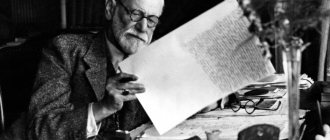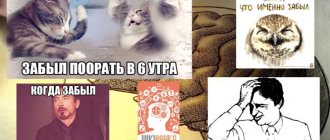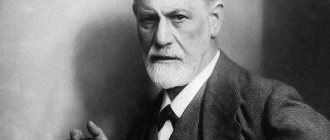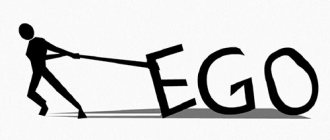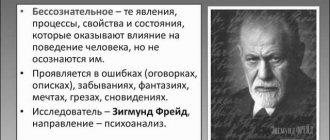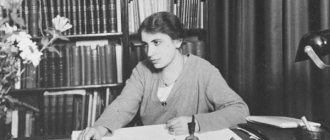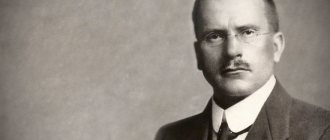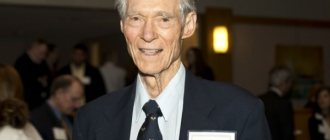PSYCHOANALYTIC THEORY OF SIGMUND FREUD
Based on biodeterminism, i.e. everyone's behavior
living beings lies the dynamics of drives.
Sigmund Freud (1856-1939) – Austrian psychologist, creator of psychoanalysis.
In 1915, his work “Attraction and Their Fates” was published, where the theory of motivation was developed.
Freud gives the psyche the main function associated with the perception of internal stimuli. Needs generate the energy of irritation, which is subjectively experienced as traumatic and unpleasant.
The subject tries to get rid of this energy or reduce it as much as possible, i.e. S. Freud's motivational theory is based on two principles:
Hedonic – any decrease in the level of accumulated irritation is accompanied by an experience of satisfaction, and an increase - dissatisfaction.
2. Homeostatic - the body’s balance is lower, the higher the level of accumulated irritation (tension).
The motivational process is aimed at reducing the energy of attraction.
ATTRACTION itself consists of elements:
- TENSION - the motor moment of the drive - the sum of forces to which the drive corresponds
- GOAL - associated with satisfaction, which can only be achieved by eliminating the irritable state of the source of attraction
- OBJECT OF ATTRACTION - something with the help or in which attraction can achieve its goal
- SOURCE OF ATTRACTION - that somatic process in an organ or part of the body, the irritation from which is represented in the mental life of the subject as an attraction.
All mental life is a dynamic of conflicts, which are based on the needs of the “I” aimed at maintaining its existence.
Types of motives:
(1) needs aimed at maintaining one’s existence (sexual desires).
(2) needs for aggression (Thanatos)
(3) attraction to life and death (Eros)
From other authors
Freud's ideological successor, Carl Gustav Jung, runs through most of his works the idea of the unconscious. The scientist, along with an analysis of Freud's approach to the study of the unconscious, developed his own doctrine of the unconscious.
His first works were thoroughly imbued with mysticism; this passion accompanied Karl throughout his entire scientific career. As his sympathy for Freud faded, more and more references to symbols and occult signs appeared. This is the main feature of his works, in addition to the theme of the unconscious in different contexts.
The book entitled “Libido, Its Metamorphoses and Symbols” will seem more than fascinating to fans of psychoanalysis. It is here that the difference in opinion between Jung and the eminent teacher becomes apparent [7].
If you are interested in a qualitative assessment of the difference in the approaches of two scientists, the work “Critique of Psychoanalysis” 1961 will shed light on many questions that may arise in your mind. Key points of work:
- Jung refutes the power of repression as the only cause of mental disorders.
- Introduces theological symbolism into the interpretation of images of the unconscious.
- For him, libido is no longer an absolute synonym for sexuality.
The book “Essays on the Psychology of the Unconscious” contains only some of Jung’s publications on the topic of the unconscious [8]. A distinctive feature is that in this book the analysis of the properties of the psyche is presented in the vein of the author’s direction of Carl Jung, analytical psychology. References to the theory of the “collective unconscious”, the discoverer of which was also the scientist, have already been presented. In his work, Jung sets out his own views on some problems of the unconscious, some of them:
- the will to power, as one of the leading sources of mental energy of the individual
- Interaction of personal and collective unconscious
- The concept of "Anima and Animus"
Another book published in Russian that laid the fundamental principles of analytical psychology, “An Approach to the Unconscious”, develops Jung’s teaching about the collective unconscious [9]. The theory of the archetypes of the unconscious as a source of universal symbolism, manifested both in dreams (individual level) and in the myths of entire nations (collective level), is considered.
A living example of the practical use of the theory of psychoanalysis in the vein of structuralism is the book “Lacan in Japan” by the famous Freudian, Jacques Lacan [10]. He talks about the possibility of applying psychoanalysis to a culture that is alien, and sometimes directly opposite, to the Western one. Lacan describes the structuring of the unconscious based on the special properties of the Japanese language in comparison with its Western counterparts.
There have also been many stand-up works written by neo-Freudians over the last century.
THEORY OF A. MASLOW
Maslow Abraham Harald (1908-1970) - American psychologist. The founder of humanistic psychology, which studies the problem of the value of man himself. Created a hierarchical model of motivation (“Motivation and Personality”, 1954).
Maslow is the author of a detailed classification of motives, the features of which are as follows:
- represents not individual, but groups of motives
— groups of motives are ordered in an integral hierarchy.
Orderliness depends on the level of development of the individual, on age and the role of the social motivating group in the development of the individual.
Needs, or groups of needs, act as the initiator of activity.
Activity is not determined from within, it is attracted from outside by the opportunity to satisfy a need.
The needs that form the hierarchy interact with each other as follows:
— until the needs of lower levels are satisfied, the needs of a higher level are not updated;
- if the subject’s needs of different levels are actualized, then the needs of the life level win in this conflict.
Hierarchy of needs (according to A. Maslow):
Level I: physiological needs (hunger, thirst, etc.);
Level II: need for safety;
Level III: the need for social connections (appearance, love, identification, affiliation, etc.);
Level IV: need for self-esteem (signs, achievements, approval, etc.);
Level V: the need for self-actualization (realization of one’s own abilities, understanding and comprehension of oneself and others).
Self-actualizing individuals make up only 1% of the total number of people.
This need is not always achieved; this is the ideal to which a person strives (or should strive).
About education and the beginning of professional development
At the age of nine, the future scientist entered the gymnasium, from which he graduated with honors at the age of seventeen. Sigmund Freud continued his studies at the Faculty of Medicine at the Vienna Institute. In 1881, the young man received his doctorate. Having initially decided to engage exclusively in theoretical science, he worked for some time in a training laboratory under the guidance of one of his mentors. But over time, under pressure from circumstances, he got a job at the Vienna City Hospital, in the surgery department.
This area of medicine did not make any particular impression on Freud, but after studying it for a couple of months, the doctor became interested in neurology. The doctor has achieved significant success in this area. The articles he published in medical journals at that time earned the doctor the reputation of a neuropathologist, capable, if not of performing miracles, then of successfully diagnosing the disease and treating it - definitely.
However, this work in the hospital did not meet Freud's inner desires. In 1883, the doctor moved to the psychiatric department, starting to work under the leadership of Theodor Meynert. And a year later, in 1884, he began to seriously study nervous diseases. In the same year, the future author begins to study the properties of cocaine, exploring its use as an anesthetic drug.
CONFLICT THEORY by K. Levin
The main provisions were developed by K. Levin.
Lewin Kurt (1890-1947) – German-American psychologist.
He was close to Gestalt psychology.
The motivational theory was outlined in the work “The Psychological Situation of Reward and Punishment” - 1931.
Used the concepts of field valency.
Valence is the force of influence of an object on the subject, which depends either on the actual need of the subject, or on the challenging nature of the object - positive valence. If opposite power relations arise (the subject encounters something unpleasant and tries to get rid of it) – negative valence.
The current field of psychological forces is determined by valences and vectors emanating from objects in the surrounding world.
Kurt Lewin presented these valences and vectors in the form of motivating forces that determine the behavior of an individual.
K. Levin introduced the concept of “FIELD AT A GIVEN MOMENT”, which is determined not only by the actual valences of objects, but also by the retrospective development of personality and the prospect of personality development:
K. Levin focused on the conflict that unfolds within the field of the subject.
A conflict can be characterized as a situation in which a subject is simultaneously affected by forces that are oppositely directed, but have approximately the same magnitude.
Types of conflict situations:
(1) Conflict “aspiration - aspiration”.
Two objects (goals) are given, they are both positive, i.e.
have positive valences. The conflict is that the subject cannot simultaneously strive for two.
(2) Avoidance-avoidance conflict.
This conflict is the opposite of the first.
Represents a situation of psychological coercion. It creates a feeling of being trapped. The subject does not seem to see the possibility of leaving the zone of 2 evils.
(3) “Striving-avoidance” conflict.
The same action simultaneously attracts and repels the subject (positive and negative valence of the same magnitude).
(4) Conflict “double desire - avoidance”.
Several goals are given, each of which is characterized by ambivalence.
Kurt Lewin identified the specifics of the action of the forces of attraction and repulsion.
The magnitude of the behavioral tendency depends on:
- value of goal valence,
- the distance to the goal that remains to be overcome.
There is a moment of balance between striving and avoidance.
Distance is not always associated with spatial distance.
It can appear in the form of distances in time, the amount of required forces, the number of necessary intermediate actions, etc.
| The smaller the distance, the greater the negative valence; the greater the distance, the greater the positive valence |
The relationship between these forces was presented in the form of a graph:
Miller D. 1944
– connected Lewin’s ideas with Hull’s hypothesis about the target gradient: the closer to the target, the fewer errors, the higher the speed of movement.
Miller put forward 6 hypotheses about the phenomenon of the “desire-avoidance” conflict:
The tendencies of aspiration are stronger, the closer the distance to the goal - the gradient of aspiration.
1. The tendency to avoid is stronger, the closer the distance to the feared stimulus - gradient.
2. The avoidance gradient grows faster than the aspiration gradient.
3. In the event of a conflict between two incompatible reactions, the stronger one wins.
The magnitude of the gradient depends on the strength of the drive.
5. The strength of the reinforced tendency of the subject to respond increases with the number of reinforcements - learning.
Gradient ratio graph:
If the distance to the target is less than X, then the avoidance gradient increases. At point X the subject oscillates between striving and avoiding.
As we approach inevitable events, the avoidance gradient decreases (the graph changes - see: dotted line graph).
What are they saying about this book?
Even during his lifetime, the works of the great scientist aroused the most controversial responses both among professional medicine practitioners and among the curious. And today Freud evokes mixed reactions. “The Psychology of the Unconscious” evokes either criticism or enthusiastic praise.
Quite interesting are the responses left by people who first became acquainted with the works of the Austrian doctor and who, before reading, had a biased attitude towards Freudianism, based largely on anecdotes, feature films, TV series and detective literature in which psychological analysis is mentioned. Quite often people discuss not so much the book as the kind of person Freud was.
Students studying at medical universities leave detailed reviews of “Psychology of the Unconscious”, full of understanding of the details. Students use various terms in them, and on thematic forums you can often encounter very lively discussions provoked by reading this book.
But not only future psychologists enthusiastically read and discuss the works of such a scientist as Freud. “Psychology of the Unconscious” makes people who are far from professional medicine want to share their thoughts and discuss some points.
Freud's teachings
Freud Sigmund (1856 - 1939) - Austrian neuropathologist, psychiatrist and psychologist, professor at the University of Vienna, the first researcher of subconscious phenomena (emigrated to Great Britain in 1938).
Developed at the end of the 19th century. a special method of treating neuroses is psychoanalysis - analysis of free associations, erroneous actions, sayings and dreams. Later, Freud interpreted it as a way of penetrating the subconscious, and then, on this basis, proposed his general psychological theory of the structure of the psyche as a continuous conflict interaction of consciousness with unconscious drives (“Interpretation of Dreams,” 1900).
Consciousness, according to Freud, continuously suppresses unconscious drives (especially sexual), which, breaking through the censorship of consciousness, manifest themselves in various sayings, jokes, slips of the tongue, and slips of the tongue (“Psychopathology of everyday life,” 1901).
Later, Freud focused on sociocultural problems (“Psychology of the masses and analysis of the human “I”, 1921; “Civilization and those dissatisfied with it,” 1929) (see History of Foreign Psychology).
The human psyche consists of two main levels: conscious and unconscious .
It is like an iceberg, most of which is hidden from direct view. The unconscious part of the psyche has been formed over millions of years in animals. Consciousness is unique to humans and has been formed for several tens of thousands of years.
The unconscious contains the driving forces of human behavior.
The psychic energy of the unconscious manifests itself directly - in aspirations aimed at the self-preservation of the individual and the development of the species (the desire to reproduce), and indirectly - in the desire for destruction, aggression against obstacles to the survival and development of one's species.
There is a specific energy of life in the psyche - the energy of procreation - libido, sexual energy . Its source is in the unconscious, it is laid down by nature itself. Libido is aimed at the development and survival of the species, the genus. However, since a person has consciousness, it can come into conflict with the unconscious libido. A person, being a part of society, wants to develop not only his family, but also himself, his personality. The only source is forced to feed both aspirations equally.
Freud introduces, in addition to the power of love (Libido, Eros), a new force - the power of death (Mortido, Thanatos). The creature comes into the world to reproduce its species and make room for the next generation. All living things contain the potential for self-destruction.
Brief summary
Psychoanalysis by Sigmund Freud is the greatest attempt to come to an understanding and description of those components of human mental life that were incomprehensible before Freud. The very term “psychoanalysis” is currently used to describe:
- Scientific discipline
- A set of measures to study mental processes
- Methods for treating neurotic disorders
Freud's work and his psychoanalysis are often criticized even today, but the concepts that he introduced (Id, Ego, Super-Ego, defense mechanisms, sublimation, libido) are understood and applied in our time by both scientists and simply educated people. Psychoanalysis is reflected in many sciences (sociology, pedagogy, ethnography, anthropology and others), as well as in art, literature and even cinema.
We also recommend reading:
- Storytelling
- Skinner's operant conditioning as a technology for personality formation
- Cognitive psychology and cognitive psychotherapy
- Halperin's theory of mental action
- Symboldrama as a way to reach the unconscious
- What is consciousness?
- A Brief History of Psychology: From Antiquity to the Present Day
- Free association method
- Fear: psychological foundations and famous scientific studies of this phenomenon
- Freudian slip: the hidden meaning of involuntary substitution of words
- Why does a person need a relationship: answers from psychologists
Key words:1Communication
Psychoanalytic method
The goal of psychoanalytic techniques is to bring the unconscious into the realm of consciousness without the use of hypnosis.
- Free association technique . The patient is placed on a comfortable couch in a small soundproofed room with soft lighting, without patterns on the wallpaper.
The purpose of such an organization is the absence of extraneous incentives. Even the psychoanalyst is placed in a chair at the head of the patient so that he does not see him and practically does not feel his presence.
Instructions to the patient: “Say everything that comes to your mind, without stopping for a second; do not stop your flow of thought by force of will.” The psychoanalyst must monitor the place where the instructions are violated and pauses appear. The session lasts no more than 40 minutes, as fatigue sets in after that.
At some point, the patient’s thought “bumps into” some obstacle and turns sharply to the side. The psychoanalyst does not interrupt the patient's story, but marks this place in the notebook.
The psychoanalyst asks the patient to talk about problem areas. Over time, the problem becomes obvious to the psychoanalyst. He clearly tells it to the patient.
The patient usually denies everything, sometimes this denial turns into aggression. The psychoanalyst must force the patient to relive this problem, accept it, and thus free himself.
- Dream interpretation.
The waking psyche does not let through some images that are prohibited by censorship or by some internal barriers. However, in a dream we see these images, although they are also veiled by the psyche, since consciousness does not let them pass in their pure form even in a dream.
- Interpretation of erroneous actions . Erroneous actions are awkward movements, slips of the tongue, missteps, jokes.
All of these are breakthroughs of the unconscious into the realm of consciousness.
The disadvantage of psychoanalysis was that it underestimated the fact that man is a social being and interacts in a system of social relations.
Freud creates a holistic doctrine of human personality. In the personality structure, he identifies:
- Id (It) is the unconscious with which a person is born. It is supported by the pleasure principle.
The unconscious is filled with libidinal energy of procreation and aggression. An increase in the energy potential of the libido creates tension, and its release is pleasure.
- Ego (I) is our consciousness, subordinate to the principle of rationality. The I is always between the Id and the Super-Ego, in the confrontation between these two structures. If we submit to the id, we pay with pangs of conscience, prohibitions of morality and law. Following the Super-Ego, we pay with neuroses and disorders.
- Super-Ego (Super-I) is an idealized person who follows the principles of public morality and duty.
This is the social part of the personality. This is an image of a person, what she could be if she followed all the rules and norms of society. However, the Super-Ego does not have its own source of energy; it is forced to feed on the same libidinal energy of the unconscious. Libido must activate two mechanisms at once, and this gives rise to intrapersonal contradictions.
Freud uses Plato's image of a charioteer who drives a chariot drawn by two horses, which are rushing in different directions, and the driver is forced to control them. Freud's theory of personality structure is complemented by the theory of personality development.
Another important part of Freud’s theory of personality was the doctrine of methods of psychological protection of the individual. When conflicts arise in the human psyche between consciousness and the unconscious, 2 fundamental forms of behavior are possible: aggression and retreat from the object.
Aggression can manifest itself in aggression towards other people and objects that we find unacceptable. Aggression can be expressed both in socialized forms of protest and in asocial forms. Auto-aggression, that is, aggression directed at oneself, is also possible.
A separate section of Freud's theory is devoted to the problem of deviation from the object.
Unconscious
The time has come to finally consider F.'s theory of the unconscious, which was so acutely perceived in its time.
The unconscious in psychoanalysis
Let's start by looking at the basics of psychoanalysis, which is inextricably linked with the concept of the unconscious.
What is said about the unconscious in psychoanalysis?
There are three subjects of psychology: Consciousness, Behavior and Unconscious Processes.
Consciousness became the subject of study by several sciences - philosophy, psychology and even anthropology; the concept itself came into use in the 17th century, as a consequence of the rapid development of the natural sciences. Behavior, as a subject of psychology, is considered by behaviorism. The third component - unconscious processes - is a fairly general term. Let's consider it in the context of this area of psychology.
You should immediately distinguish between the concepts of unconscious or unconscious according to the following principles:
The term unconscious covers a larger number of processes, which are divided into two types:
The first type of questions answers the question “How?” .
Speaking about such a process as a skill, we can assume that when sufficiently formed and developed, it begins to be produced {becomes automated} without the intervention of consciousness. {/tip} We attribute this phenomenon to unconscious mechanisms (UM). Consequently, this type of unconscious does not in any way belong to the category of the Unconscious.
The second type of questions is {tipt. e. “What motive causes the action? } "For what?" {/tip}.
Obviously, a person always has a reason for his actions. But is it always “consciously recognized”? - that's another question. If it is not realized, then we are talking about a specific type of phenomenon - the unconscious motives of the NP (motives, aspirations, drives) leading to the execution of an action. The NP is the Unconscious.
So, in the practice of hypnosis, the subject is given the setting - “After a certain period of time, you must perform a certain act.” Post-hypnotic amnesia, of course, will not allow a person consciously remember what the hypnologist said, but he will carry out this installation (action) in real life.
The patient is reasonably asked the question “Why did you do this?” - An honest person will answer: “I don’t know,” another will come up with an excuse. Moreover, this explanation will in no way reveal the true motive of what was done. In a specific case, the invented justification is an example of the Unconscious. And most importantly, the patient himself begins to believe in the fable he has invented. This is how B. manifests itself in real life. This incident should be remembered.
As a result, Freud's portrait of a typical clinical patient looks like this:
- The cause of this patient's distress is always the unconscious. The patient is clearly aware of his impressions and experiences
- It should be noted that consciousness has an important function - to understand (the world and oneself in it). What about Freud's patient? Consciousness is present. It is a fact.
But does a person’s own consciousness allow him to understand himself? - No.
- Consequently, consciousness does not fulfill its main function.
- We state that the patient is aware of himself, but inadequately (the same “For what?” interjects). For the patient's consciousness, the true motivation remains beyond the unconscious.
Literally “translating” the meaning of the word “Unconscious”, we get - “ Consciousness without understanding .” Such consciousness does not answer the question about the true motives of human behavior. Symptom: The patient has difficulty managing himself. This is exactly the picture of the disease that we see in the “Freud patient.”
Methods of psychological protection
Crowding out . Suppression, exclusion from consciousness of unpleasant or unacceptable impulses. In this case, they are transferred to the unconscious. Substitution .
Reorientation of impulse from one object to another, more accessible one. Rationalization . An attempt to rationally justify desires and actions caused by such a reason, the recognition of which would threaten the loss of self-esteem. Projection .
Unconscious transfer of one's own feelings and attractions to another person. Somatization . Fixation on the state of one's health as a form of protection from conflicts. Reactive education . Replacing unacceptable tendencies with the exact opposite. Regression . Return to primitive forms of behavior in a difficult situation. Denial . Unfulfilled desires, thoughts, and impulses are not recognized.
Their very existence is denied. Sublimation . Transformation of socially unacceptable impulses into socially acceptable and encouraged ones. The clearest example is the sphere of art.
Internal perceptions. The problem of pain at the external/internal boundary
Freud emphasizes that the relationship of internal perception to the Self requires detailed study, since here he asks the question of the legitimacy of attributing consciousness to the interconnection B - SZ. I would like to understand more about his phrase that internal perception gives a feeling of processes from various and deepest layers of the mental apparatus. How this conclusion was reached is not entirely clear, since it further suggests that these processes are little known. However, we cannot but agree with this obscurity. It is generally not known how to talk about those processes that no one knows about and that are difficult to analyze. What Freud says about the presence of a "vague consciousness" emphasizes how shaky and unsteady the ground is being touched upon in this study.
By pain, the author understands something in between external and internal perception, a manifestation of internal perception, including when the causes come from the external world. This statement is quite close and accepted, since any processing of the external world can come from the inner psychic person.
Clinical aspects of the need for a second topical model
As we can understand from reading this text by Freud, he gives a number of clinical examples from practice that prove the existence of a structure of the psyche dividing it into Ego, Super-Ego and Id, describing various types of resistance, desire for illness, narcissistic phenomena, feelings of guilt, etc. .P. All these manifestations in the behavior of patients indicate that there is a certain mechanism in the psyche that, on the one hand, wants to be cured, but on the other hand, resists this in every possible way. The emergence of these feelings, for example, guilt, is determined by the author by the presence of tension between the Self and the Super-Ego.
Thus, the author, using further examples, proves the existence of a topical model of the psyche, its main manifestations and expressions in the form of feelings and experiences of patients, transmitted by them outward.
Two types of drives and their correlation with the second topical model
In this work, Freud asks the question of the correlation between the formations of the Ego, Super-Ego and Id and the primary urges (sexual instincts and death instincts). He first tries to describe this connection by pointing out the presence of polarities of love and hatred, highlighting such a phenomenon as ambivalence. However, he further comes to the conclusion that these relationships cannot be described by an increase in simple hostility. And finally, he comes to the idea of the presence of so-called indifferent energy, which can carry both erotic and destructive impulses. This energy acts in the formations of the psyche in accordance with the division according to the second topical model. Of course, it would probably be difficult to explain the movements of drives in any other way, except as a process of energy transformation. In principle, the description of many laws of nature is based on this transformation.
